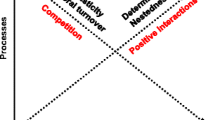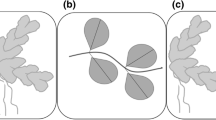Abstract
Fluctuations in nutrient ratios over seasonal scales in aquatic ecosystems can result in overyielding, a condition arising when complementary life-history traits of coexisting phytoplankton species enables more complete use of resources. However, when nutrient concentrations fluctuate under short-period pulsed resource supply, the role of complementarity is less understood. We explore this using the framework of Resource Saturation Limitation Theory (r-strategists vs. K-strategists) to interpret findings from laboratory experiments. For these experiments, we isolated dominant species from a natural assemblage, stabilized to a state of coexistence in the laboratory and determined life-history traits for each species, important to categorize its competition strategy. Then, using monocultures we determined maximum biomass density under pulsed resource supply. These same conditions of resource supply were used with polycultures comprised of combinations of the isolated species. Our focal species were consistent of either r- or K-strategies and the biomass production achieved in monocultures depended on their efficiency to convert resources to biomass. For these species, the K-strategists were less efficient resource users. This affected biomass production in polycultures, which were characteristic of underyielding. In polycultures, K-strategists sequestered more resources than the r-strategists. This likely occurred because the intermittent periods of nutrient limitation that would have occurred just prior to the next nutrient supply pulse would have favored the K-strategists, leading to overall less efficient use of resources by the polyculture. This study provides evidence that fluctuation in resource concentrations resulting from pulsed resource supplies in aquatic ecosystems can result in phytoplankton assemblages’ underyielding.



Similar content being viewed by others
References
Beckage B, Gross LJ (2006) Overyielding and species diversity: what should we expect? New Phytologist 172:140–148. https://doi.org/10.1111/j.1469-8137.2006.01817.x
Bruno JF, Lee SC, Kertesz JS, Carpenter RC, Long ZT, Duffy JE (2006) Partitioning the effects of algal species identity and richness on benthic marine primary production. Oikos 115:170–178. https://doi.org/10.1111/j.2006.0030-1299.14927.x
Buyukates Y, Roelke D (2005) Influence of pulsed inflows and nutrient loading on zooplankton and phytoplankton community structure and biomass in microcosm experiments using estuarine assemblages. Hydrobiologia 548:233–249. https://doi.org/10.1007/s10750-005-5195-x
Cardinale BJ, Matulich KL, Hooper DU, Byrnes JE, Duffy E, Gamfeldt L, Balvanera P, O’Connor MI, Gonzalez A (2011) The functional role of producer diversity in ecosystems. Am J Bot 98:1–21. https://doi.org/10.3732/ajb.1000364
Cardinale BJ, Duffy JE, Gonzalez A, Hooper DU, Perrings C, Venail P, Narwani A, Mace GM, Tilman D, Wardle DA, Kinzig AP, Daily GC, Loreau M, Grace JB, Larigauderie A, Srivastava DS, Naeem S (2012) Biodiversity loss and its impact on humanity. Nature 486:59–67. https://doi.org/10.1038/nature11148
Corcoran AA, Boeing WJ (2012) Biodiversity increases the productivity and stability of phytoplankton communities. PLoS One 7(11):e49397. https://doi.org/10.1371/journal.pone.0049397
Dimitrakopoulos PG, Schmid B (2004) Biodiversity effects increase linearly with biotope space. Ecol Lett 7:574–583. https://doi.org/10.1111/j.1461-0248.2004.00607.x
Duffy JE (2009) Why biodiversity is important to the functioning of real-world ecosystems. Front Ecol Envir 7:437–444. https://doi.org/10.1890/070195
Fox JW (2005) Interpreting the ‘selection effect’ of biodiversity on ecosystem function. Ecol Lett 8:846–856. https://doi.org/10.1111/j.1461-0248.2005.00795.x
Fridley JD (2001) The influence of species diversity on ecosystem productivity: how, where, and why? Oikos 93:514–526. https://doi.org/10.1034/j.1600-0706.2001.930318.x
Gamfeldt L, Hillebrand H (2008) Biodiversity effects on aquatic ecosystem functioning: maturation of a new paradigm. Int Rev Hydrobiol 93:550–564. https://doi.org/10.1002/iroh.200711022
Grover JP (1990) Resource competition in a variable environment: phytoplankton growing according to Monod’s model. Am Nat 136:771–789. https://doi.org/10.1086/285131
Guillard RRL, Ryther JH (1962) Studies of marine planktonic diatoms. I. Cyclotella nana Hustedt and Detonula confervacea Cleve. Can J Microbiol 8:229–239. https://doi.org/10.1139/m62-029
Hector A (1998) The effect of diversity on productivity: detecting the role of species complementarity. Oikos 82:597–599. https://doi.org/10.2307/3546380
Hector A, Schmid B, Beierkuhnlein C, Caldeira MC, Diemer M, Dimitrakopoulos PG, Finn JA, Freitas H, Giller PS, Good J, Harris R, Hogberg P, Huss-Danell K, Joshi J, Jumpponen A, Korner C, Leadley PW, Loreau M, Minns A, Mulder CPH, O’Donovan G, Otway SJ, Pereira JS, Prinz A, Read DJ, Scherer-Lorenzen M, Schulze ED, Siamantziouras ASD, Spehn EM, Terry AC, Troumbis AY, Woodward FI, Yachi S, Lawton JH (1999) Plant diversity and productivity experiments in European grasslands. Science 286:1123–1127. https://doi.org/10.1126/science.286.5442.1123
Hector A, Hautier Y, Saner P, Wacker L, Bagchi R, Joshi J, Scherer-Lorenzen M, Spehn EM, Bazeley-White E, Weilenmann M, Caldeira MC, Dimitrakopoulos PG, Finn JA, Huss-Danell K, Jumpponen A, Mulder CPH, Palmborg C, Pereira JS, Siamantziouras ASD, Terry AC, Troumbis AY, Schmid B, Loreau M (2010) General stabilizing effects of plant diversity on grassland productivity through population asynchrony and overyielding. Ecology 91:2213–2220. https://doi.org/10.1890/09-1162.1
Hill GA, Robinson CW (1974) Measurement of aerobic batch culture maximum specific growth rate and respiration coefficient using a dissolved oxygen probe. Biotechnol Bioeng 16:531–538. https://doi.org/10.1002/bit.260160409
Hillebrand H, Durselen CD, Kirschtel D, Pollingher U, Zohary T (1999) Biovolume calculation for pelagic and benthic microalgae. J Phycol 35:403–424. https://doi.org/10.1046/j.1529-8817.1999.3520403.x
Huston A (1997) Hidden treatments in ecological experiments: re-evaluating the ecosystem function of biodiversity. Oecologia 110:449–460. https://doi.org/10.1007/s004420050180
Katechakis A, Stibor H, Sommer U, Hansen T (2002) Changes in the phytoplankton community and microbial food web of Blanes Bay (Catalan Sea, NW Mediterranean) under prolonged grazing pressure by doliolids (Tunicata), cladocerans or copepods (Crustacea). Mar Ecol Prog Ser 234:55–69. https://doi.org/10.3354/meps234055
Kilham P, Kilham SS (1980) The evolutionary ecology of phytoplankton. In: Morris I (ed) The physiological ecology of phytoplankton. University California Press, Berkley, pp 571–597
Kirk JTO (1994) Light and photosynthesis in aquatic ecosystems. Cambridge University Press, Cambridge
Lambers JHR, Harpole WS, Tilman D, Knops J, Reich PB (2004) Mechanisms responsible for the positive diversity—productivity relationship in Minnesota grasslands. Ecol Lett 7:661–668. https://doi.org/10.1111/j.1461-0248.2004.00623.x
Loreau M (1998) Separating sampling and other effects in biodiversity experiments. Oikos 82:600–602. https://doi.org/10.2307/3546381
Loreau M, Hector A (2001) Partitioning selection and complementarity in biodiversity experiment. Nature 412:72–76. https://doi.org/10.1038/35097128
Moore CM, Mills MM, Arrigo KR, Berman-Frank I, Bopp L, Boyd PW, Galbraith ED, Geider RJ, Guieu C, Jaccard SL, Jickells TD, La Roche J, Lenton TM, Mahowald NM, Marañón E, Marinov I, Moore JK, Nakatsuka T, Oschlies A, Saito MA, Thingstad TF, Tsuda A, Ulloa O (2013) Processes and patterns of oceanic nutrient limitation. Nat Geosci 6:701–710. https://doi.org/10.1038/NGEO1765
Mueller KE, Tilman D, Fornara DA, Hobbie SE (2013) Root depth distribution and the diversity–productivity relationship in a long-term grassland experiment. Ecology 94:787–793. https://doi.org/10.1890/12-1399.1
O’Connor MI, Gonzalez A, Byrnes JEK, Bradley J, Cardinale J, Duffy E, Gamfeldt L, Griffin JN, Hooper D, Hungate BA, Paquette A, Thompson PL, Dee LE, Dolan KL (2016) A general biodiversity—function relationship is mediated by trophic level. Oikos 000:001–014. https://doi.org/10.1111/oik.03652
Parsons TR, Maita Y, Lalli CM (1984) A manual of chemical and biological methods for seawater analysis. Pergamon Press, Oxford
Power LD, Cardinale BJ (2009) Species richness enhances both algal biomass and rates of oxygen production in aquatic microcosms. Oikos 118:1703–1711. https://doi.org/10.1111/j.1600-0706.2009.17585.x
Ptacnik R, Solimini AG, Andersen T, Tamminen T, Brettum P, Lepistö L, Willén E, Rekolainen S (2008) Diversity predicts stability and resource use efficiency in natural phytoplankton communities. PNAS 105:5134–5138. https://doi.org/10.1073/pnas.0708328105
Pujo-Pay M, Raimbault P (1994) Improvement of the wet oxidation procedure for simultaneous determination of particulate organic nitrogen and phosphorus collected on filters. Mar Ecol Prog Ser 105:203–207. https://doi.org/10.3354/meps105203
Reynolds CS (1993) Scales of disturbance and their role in plankton ecology. Hydrobiologia 249:157–171. https://doi.org/10.1007/BF00008851
Reynolds C (2006) The ecology of phytoplankton. Cambridge Univ. Press, New York
Roelke DL, Spatharis S (2015) Phytoplankton succession in recurrently fluctuating environments. PLoS One 10:e0121392. https://doi.org/10.1371/journal.pone.0121392
Roscher C, Thein S, Schmid B, Scherer-Lorenzen M (2008) Complementary nitrogen use among potentially dominant species in a biodiversity experiment varies between two years. J Ecol 96:477–488. https://doi.org/10.1111/j.1365-2745.2008.01353.x
Schabhüttl S, Hingsamer P, Weigelhofer G, Hein T, Weigert A, Striebel M (2013) Temperature and species richness effects in phytoplankton communities. Oecologia 171:527–536. https://doi.org/10.1007/s00442-012-2419-4
Schmidtke A, Gaedke U, Weithoff G (2010) A mechanistic basis for underyielding in phytoplankton communities. Ecology 91:212–221. https://doi.org/10.1890/08-2370.1
Shurin JB, Abbott RL, Deal MS, Kwan GT, Litchman E, McBride RC, Mandal S, Smith VH (2013) Industrial-strength ecology: trade-offs and opportunities in algal biofuel production. Ecol Lett 16:1393–1404. https://doi.org/10.1111/ele.12176
Singh M, Awasthi A, Soni SK, Singh R, Verma RK, Kalra A (2015) Complementarity among plant growth promoting traits in rhizospheric bacterial communities promotes plant growth. Sci Rep 5:15500. https://doi.org/10.1038/srep15500
Smeti E, Roelke DL, Spatharis DL (2016) Spatial averaging and disturbance lead to high productivity in aquatic metacommunities. Oikos 125:812–820. https://doi.org/10.1111/oik.02684
Sommer U (1989) The role of competition for resources in phytoplankton ecology. In: Sommer U (ed) Plankton ecology: succession in plankton communities. Springer-Verlag, Berlin, pp 57–106
Spatharis S, Tsirtsis G, Danielidis DB, Chi TD, Mouillot D (2007) Effects of pulsed nutrient inputs on phytoplankton assemblage structure and blooms in an enclosed coastal area. Estuar Coas Shelf Sci 73:807–815. https://doi.org/10.1016/j.ecss.2007.03.016
Suttle CA, Stockner GJ, Harrison PJ (1987) Effects of nutrient pulses on community structure and cell-size of a freshwater phytoplankton assemblage in culture. Can J Fish Aquat Sci 44:1768–1774. https://doi.org/10.1139/f87-217
Tilman D (1982) Resource competition and community structure. Princeton University Press, Princeton, New Jersey
Tilman D, Wedin D, Knops J (1996) Productivity and sustainability influenced by biodiversityin grassland ecosystems. Nature 379:718–720. https://doi.org/10.1038/379718a0
Tilman D, Reich PB, Knops J, Wedin D, Mielke T, Lehman C (2001) Diversity and productivity in a long-term grassland experiment. Science 294:843–845. https://doi.org/10.1126/science.1060391
Utermöhl H (1958) Zur vervollkommnung der quantitativen phytoplankton-methodik. Verh Int Ver Theor Angew Limnol 9:1–38
Wardle DA (1999) Is "sampling effect" a problem for experiments investigating biodiversity-ecosystem function relationships? Oikos 87:403–407. https://doi.org/10.2307/3546757
Weis JJ, Cardinale BJ, Forshay KJ, Ives AR (2007) Effects of species diversity on community biomass production change over the course of succession. Ecology 88:929–939. https://doi.org/10.1890/06-0943
Weis JJ, Madrigal DS, Cardinale BJ (2008) Effects of algal diversity on the production of biomass in homogeneous and heterogeneous nutrient environment: a microcosm experiment. PLoS One 3:e2825. https://doi.org/10.1371/journal.pone.0002825
Acknowledgements
The authors would like to thank Ulrich Sommer, Jason Matthiopoulos, Georg Pohnert and three anonymous reviewers for their essential comments on this research work.
Author information
Authors and Affiliations
Contributions
DLR and SS originally formulated the idea. SS and ES designed the experiments. LAP performed the experiments. DBD, ES, LAP measured the species traits. SS, ES, GDK, LAP performed statistical analysis. ES, SS, PGD, DLR provided the ecological and mechanistic interpretation of experimental results. SS, ES, GDK, LAP wrote the manuscript and DLR provided editorial advice. LAP, ES, SS and DLR revised the manuscript.
Corresponding author
Additional information
Communicated by Ulrich Sommer.
Rights and permissions
About this article
Cite this article
Papanikolopoulou, L.A., Smeti, E., Roelke, D.L. et al. Interplay between r- and K-strategists leads to phytoplankton underyielding under pulsed resource supply. Oecologia 186, 755–764 (2018). https://doi.org/10.1007/s00442-017-4050-x
Received:
Accepted:
Published:
Issue Date:
DOI: https://doi.org/10.1007/s00442-017-4050-x




